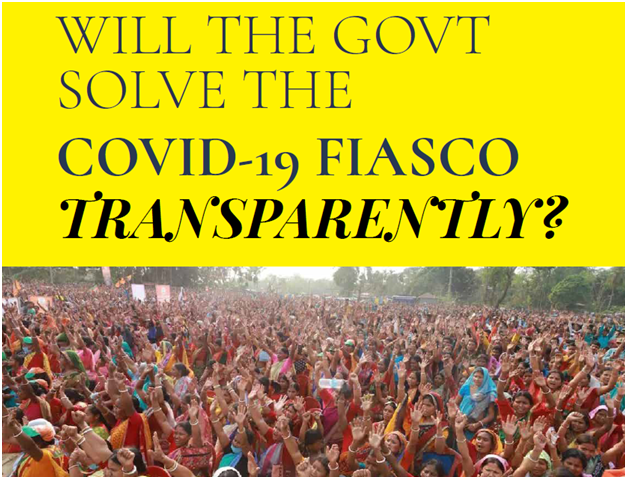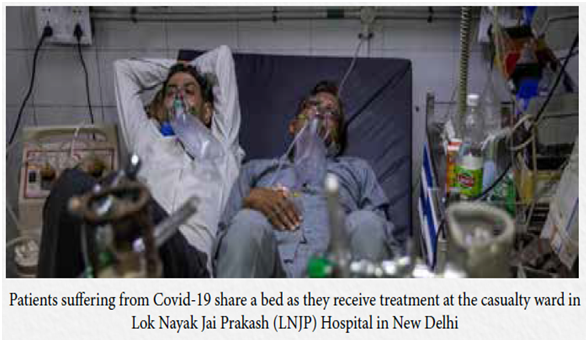
Has the Central government remained indifferent to the second wave of the Covid-19 pandemic situation that is rocking the nation now? The lurking suspicion is prevailing in the minds of the people as an atmosphere had been created till December last year that the deadly disease that made an inroad into the entire world last year, courtesy China, was controlled with precision, especially in India. The government realised the dastardly effect and its catastrophe when the crisis escalated and reached an alarming proportion from February this year.
However, the problem cropped up when the Union Health Minister cautioned the patients not to visit the hospitals, as the oxygen was available in plenty. The patients, however, much to their chagrin and discomfiture found out the shortage of oxygen and drugs like remdesivir.
The reason behind the government’s complexity on the grave issue is not too far to seek off, as the BJP was marshalling its energy on the Bihar assembly poll last year and like any other political party, it was focusing its attention on the recent assembly elections to five states – West Bengal, Assam, Tamil Nadu, Kerala and Puduchery. What was harder to understand is why corrective action was not taken at the beginning of this wave when the pandemic cases started increasing rapidly in Maharashtra and Punjab. There were more than enough indications that the situation was going out of control. And importantly, if the government did not predict the intensity of the wave, the harsh reality that it was happening at a mammoth scale must have dawned on them to limit large gatherings and reinforce safe behaviour with proper masking and isolation method.
By the time the government woke up, it was too late. Not surprisingly, the gravity of the situation made the hospitals and patients crying for attention, obviously due to inadequate beds, drugs and logistics around the supplies of oxygen. Adding fuel to the fire, the supply constraints that the vaccine manufacturers are facing now could not have come at a worse time, given the intensity of the wave, according to Chandiraka Bhadur, Chairperson of the Regional Task Force of the Lancer Commission. She is perhaps right, as India need to ramp up production and distribution urgently. What is, however, causing disturbance is that when India prepared reasonably well for the pandemic last year, how come the government let the cat out of the bag under the assumption that India, henceforth, would not come across another pandemic crisis that would loom large on the nation for quite some time?
It may be recalled that the Centre made a significant achievement a few months when it entrusted the responsibility to the two manufacturers of vaccines in Ahmedabad and Hyderabad, but the issue went out of hand, as the government had initially felt that it would not create a viable impact. By the time, the government realised its potentiality, all hell broke lose as the opposition made a mountain of molehill of the issue. All the parties were not serious about the ramifications of its effect till few months ago, but the deteriorating situation in Maharashtra made them to realise that all is not well.
Amid a crisis of vaccine supply, the Health Ministry had said that a little over one crore vaccines remain in stock with states and an additional 57 lakh would be made available to States over the weekened. Maharashtra led the table of vaccines adminisitered with 1.5 crore doses followed by Rajasthan with 1.3 crore, Uttar Pradesh, 1.25 crore, and Gujarat, 1.23 crore. These were also the States that had so far received the maximum number of vaccines. Among large states, Tamil Nadu reported a high percentage of vaccine wastage, nearly 5.72 per cent and made the crisis from bad to worse by encouraging the Tasmac shops to open their outlets for the boozers to remain in ineberiated condition.
The Andaman and Nicobar Islands, Arunachal Pradesh, Goa, Himachal Pradesh, Kerala, Mizoram and Odisha were the other states that had reported no wastage. Of all the states Odisha was prudent enough to impose full lockdown for a month, till April 30 and if the situation worsens, the state Chief Minister Navin Patnaik would not hesitate to extend the lockdown period for another month or two. What prompted the Centre to hesitiate intially when both Serum Institute of India and Bharat Bioetech had promised to manufacture 112 million doses or 115 million doses per month, ask some medial experts. There is no iota of doubt that the government vacillated on the issue before the saner counsel prevailed on them to grant a green signal to them.
What the government was trying to do is to keep the vaccines at market prices. These prices are quite high, says K. Sujata Rao, former Union Health Secretary, who is also the author of the book, “Do we care India’s Health System’, before adding that the state governments may not be able to afford to supply the vaccines free or only the richer sections among this age group, who can afford the prices, will be able to get vaccinated. She is perhaps right, as it is some kind of market segmentation and fragmentation that the government is trying to enforce in order to get supply and demand to sync at some level. Moreover, the Supreme Court has asked the Centre to supply vaccines at free of cost to the people from all walks of life when the government is already facing financial crunch.
The Central government has a constitutional obligation to stop the inter-State transfer of infectious diseases, under the Concurrent List, says K.M. Gopakumar, the well-known legal adviser, who works on the global intellectual property regime and its impact on developing countries. He also asserted that the state governments are no doubt responsible for public health. Mr Gopakumar is quite right, as earlier the Central government, has had national programmes to combat all infectious diseases, and has supplied vaccines, drugs and consummables at very low prices because of market power. But what brings the Centre to entrust the advantage to the state govenments to implement the programme now is the question baffling the people.
The anaemic pace of the government’s vaccination drive is unlikely to slow the ferocity of this second wave of the pandemic, views Thomas Abraham, Associate Professor, University of Hongkong, before remarking that it could peak by the middle of May and gradually decline. One cannot afford to ignore his warning, as there is one thing to be learned from the tragedy unfolding before the people is that unless active measures are in progress, this second wave will be followed by a third wave, and perhaps more. If we look around the world, the United States has had three distinct waves since last March, as has Brazil. The United Kingdom had a small first wave, followed by nearly four months when cases were low and the virus seemed to be disappearing. But considering India’s population, the slow pace of vaccination, inelastic vaccine supplies both in India and globally, and limited finances with State Governments which have now been given the responsibility of vaccinating the bulk of the country’s popultion, this is not going to happen quickly enough to blunt either this or future waves.
The Maharashtra government has indicated that it may take a month or more before they start vaccinating this demographic. Many of the other states have promised free vaccinations but there is no clarity on when there will be a full-flooded rollout. Limitations in the domestic supply can be supplemented by states through imports. There are, however, constraints here. States are in the frontline of dealing with the current surge in Covid-19 cases and not really equipped to deal with the additional burden of contracting with overseas manufacturers. Also, the global supply siuation is tightening as the fear of virus variants is increasing the likelihood of countries resorting to booster shots, informs some economic commentators.
K.V. VENUGOPAL
To read the further articles please get your copy of Eastern Panorama May, June issue @http://www.magzter.com/IN/Hill-Publications/Eastern-Panorama/News/ or mail to contact @easternpanorama.in


